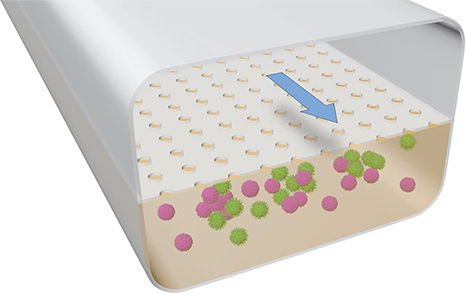Researchers at the Harvard Wyss Institute have created a microfluidic chip that contains lymphoid follicle-like structures, allowing them to model complex immune responses to various pathogens and vaccines. The breakthrough could let scientists to more comprehensively probe the complex workings of the immune system.
Lymphoid follicles are found in lymph nodes, and are the site of complex immune reactions which have not been easy to model in the lab to date. The new chip, called the LF chip, contains human B and T cells, and the Wyss researchers discovered that the cells would spontaneously form lymphoid follicle-like structures when they moved liquid through the chip.
The immune system is breathtaking in its power and complexity, and there is much about it that we still don’t understand. A simple example reads in the reactions of different people to COVID-19, which vary from a complete lack of symptoms to a full blown cytokine storm that leads to death. Specific characteristics of the immune system are likely to underlie these inter-individual differences, at least in part, but we still haven’t identified them.
Part of the problem lies in the research techniques that we have been using to date. Simply studying cells in a dish does not come close to replicating the complexity of the immune system in the human body. While experimental animals do have fully faceted immune systems, they pose a variety of ethical, practical, and financial hurdles for comprehensive research, and don’t fully replicate human immune responses.
A potential alternative lies in microfluidic systems, which can allow for more advanced cell culture systems that more accurately mimic the conditions found in the human body, including culturing various cell types together under conditions of fluid flow. In this latest research, these Harvard researchers have serendipitously discovered a technique that allows them to mimic lymphoid follicles on a microfluidic chip.

When B cells and T cells were cultured in the LF chip under flow conditions (left), they spontaneously formed 3D structures that were later identified as nascent lymphoid follicles. When the same cells were cultured in static conditions (right), no structures formed. Credit: Wyss Institute at Harvard University
By culturing human B and T cells together under conditions of fluid flow, the researchers observed that the cells spontaneously formed ‘germinal centers,’ which are structures found within lymphoid follicles. So far, the researchers have used the chip to test the immune reaction to pathogens, such as dead bacteria, and vaccines, such as one for influenza.
“The flurry of vaccine development efforts sparked by the COVID-19 pandemic were impressive for their speed, but the increased demand suddenly made traditional animal models scarce resources,” said Donald Ingber, a researcher involved in the study. “The LF Chip offers a cheaper, faster, and more predictive model for studying human immune responses to both infections and vaccines, and we hope it will streamline and improve vaccine development against many diseases in the future.”
Studies in Advanced Science: Ectopic Lymphoid Follicle Formation and Human Seasonal Influenza Vaccination Responses Recapitulated in an Organ-on-a-Chip
